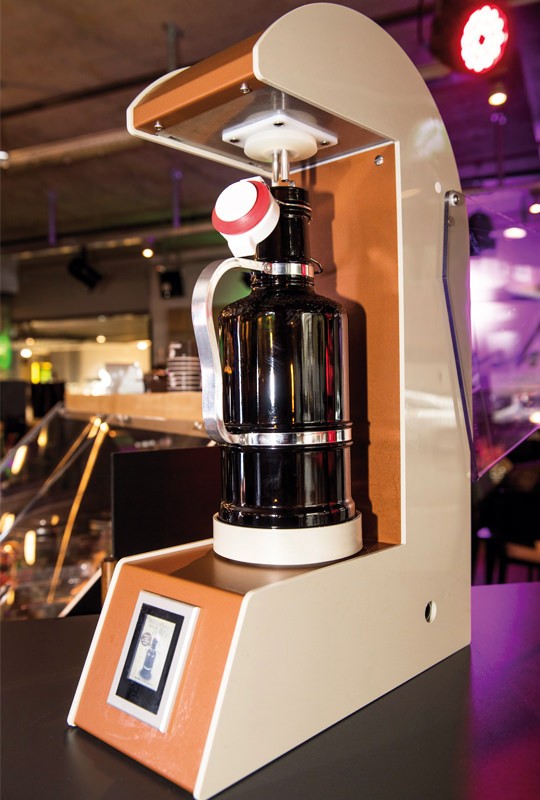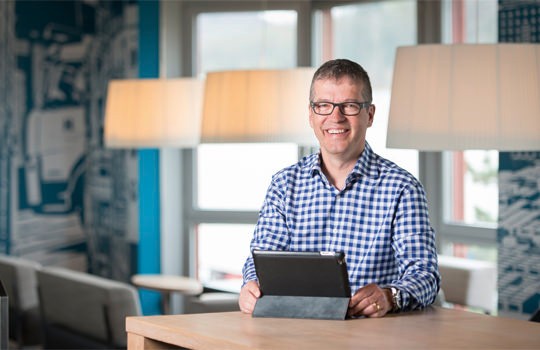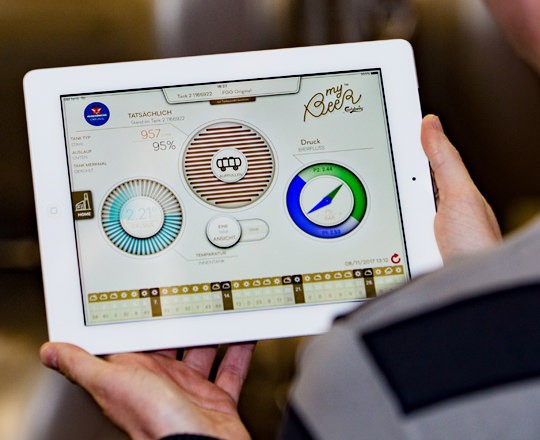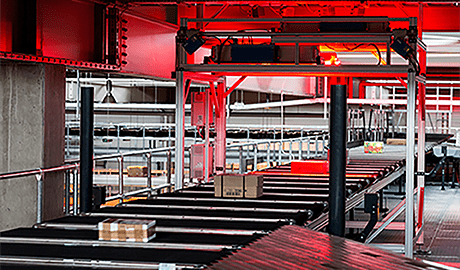IoT: Innovation processes in companies
Internet of Things: Swisscom and Feldschlösschen network beer.
Feldschlösschen taps into the Internet of Things, networking its beer tanks and taps. As an industry outsider, how do you bring about such innovative projects? Project members tell all.
Until recently, bar operator Markus A. had to check the level in his beer tank by peering through the peephole in the torchlight. If he forgot to do so before the weekend, he could find himself with no beer left. Now, he no longer needs to worry about that. His networked beer tank measures the fill level and autonomously requests a refill from Feldschlösschen, when required. Recently, the Feldschlösschen beverage group has also networked the taps that consumers use to fill up their refillable bottles. The flexible beer stations register when and where a particular beer is dispensed and provide information about the current fill level.
The networked devices and systems bring added value both for customers and for the Feldschlösschen beverage group. “This is allowing us to increase efficiency as we are now saving thousands of kilometres for our suppliers. On top of this, we have also been able to improve sustainability,” says Manfred Weiss, Service Director at the Feldschlösschen beverage group. But how does a drinks manufacturer come to the daring idea of networking its long-standing systems and make use of the Internet of Things in the first place?

Beer Station
“This requires openness, motivation, an agile team and a willingness to take risks”
“It was actually the customers who gave us the idea of finding a better solution for visualising the beer fill levels. Another reason was that we wanted to increase the efficiency of supplies,” says Manfred Weiss. Within the small project team, we soon came to the idea of tackling the problem with an IoT solution. But before this could happen, we had to overcome a few hurdles. “There is always some internal resistance in projects like this,” says Weiss. For this reason, he explains, it is important to have good change management to bring employees on board from the start, to enable transparent communication and to demonstrate passion for the project. In his view, it is also fundamental that the company management is willing to take a certain amount of risk in pioneering work such as this and, above all, you need to have dynamic work methods for the teams involved.

Manfred Weiss, Service Director at the Feldschlösschen beverage group
This sounds clear, but what does it mean in real terms? “A project of this kind would never have been feasible with our inhouse IT department. With the IoT idea, we have broken away from tradition and worked in a very lean manner, have kept administration as low as possible and have placed the focus in both projects on implementation. At the end of the day, we already have enough analyses and strategies; we didn’t draw up any service descriptions or functional descriptions or requirement lists,” explains Manfred Weiss. This working method was very successful at the beer stations. “We were able to see this project through as strategically as planned,” says Weiss, assuredly. Despite this, there were technical obstacles. The problems lay somewhat in the data transfer between the beer station hardware and the interface to the IoT module, which did not function very well at the start because of the firmware. “At the beer stations, we focused even more on costs and speed than on the networked tanks.” This was reflected in the speed of development: when developing the software, mockups were created directly from the ideas and, at the beer stations, after carrying out short tests with the first prototype, a second was soon built, followed by a small series for test customers. “Although this proved itself to be successful, we did learn that, in the future, we should carry out a pilot phase in which the prototypes are sufficiently tested before beginning the rollout,” says Weiss. Time, however, was a great leveller here: “We had to increase the time to market as a result.”
“Without partners, it just doesn’t work”

Jaap Vossen, until May 2018 Head of IoT at Swisscom
Feldschlösschen has been involved for a few years in the start-up company Softwarebrauerei AG, which is responsible for the beer station software, the dashboards and the websites for customers. “We work closely together, pathways are short and administration kept low,” says Weiss. Feldschlösschen also works with Swisscom, though not in a customary “supplier relationship”. It is more a case of collaboration in partnership, with both sides benefiting. “Depending on needs and available expertise, we develop the right solution together with the customer and provide support in the innovation process,” says Jaap Vossen, until May 2018 Head of IoT at Swisscom. “We offer a complete end-to-end service for IoT projects. We not only provide the infrastructure, we also offer support in various ways, from integrating networked devices into the ecosystem of a company to connection to the cloud and up to operation and support.”
As Feldschlösschen is a drinks manufacturer and not an IoT specialist, collaboration with an experienced partner was even more important, with specific role distribution playing an indispensable role. “If the company’s digital maturity is not yet advanced, we normally take on more tasks,” explains Vossen. Another partner is the Austrian company, Redl GmbH, which developed the beer station hardware, i.e. the actual tap, together with Feldschlösschen.

The myBeer app provides bar keepers with a range of information, including current beer levels.
“IoT is not simply a case of networking things”
“Some companies come to us with an idea or concrete issue. They assume that IoT can be the solution for their problem; however, the exact nature of this solution only becomes clear over the course of the project,” explains Jaap Vossen. He also stresses that you need an open attitude and dynamic working methods, as not all the project details can be defined from the start. “It is relatively simple to network individual devices. However, if the intention is to integrate many devices into one ecosystem, this is not possible without the right expertise and experience from similar projects,” says Thomas Winkler, Product Manager IoT at Swisscom. An error that many companies make, he explains, is that they spend only a small amount of time thinking about how their traditional product, which they want to intelligently convert into a new version, can change processes in other areas of the company. “IoT is not simply an increase in efficiency for just that product and the processes involved; it can also be the case that introducing IoT moves the focus from production more towards service,” says Winkler. With networking, for example, services can be turned completely upside down as a result of remote maintenance or, by analysing incoming data, customer behaviour can be measured, which may have an impact on marketing.

Thomas Winkler, Product Manager IoT at Swisscom
For this reason, an IoT project can generally not be considered in isolation but must be coordinated throughout the organisation. It is important that the customer is clear on where it places the focus. Jaap Vossen speaks from experience: “The majority of customers have many ideas. The difficulty lies in narrowing things down. Our task is to make the customers aware that networking can cause big changes in operations.”
“At some point, everything will be networked”
In principle, the use of IoT is open to all sectors. On an international scale, it is primarily the automobile and energy industries that rely on this new technology. In Switzerland, there are innovative companies from all sectors, as well as start-ups, which are driving IoT forward and achieving increases in efficiency or optimising workflows using digitised business models. The technology is therefore also leading to success in industries in which the networking of things has not yet played a significant role. For this reason, entrepreneurs even in areas with low digitisation should have a clear understanding that, suddenly, completely new solutions can be used for an old problem. “Sometimes, it is even the only solution,” says Jaap Vossen, highlighting the urgency for the IoT in the increasingly digitised world. The areas in which you begin connecting products and things to the Internet do not seem to be important as, “at some point, all products and objects will be networked anyway”.
Swisscom on hand along the IoT journey
Swisscom organised all the data management for Feldschlösschen’s IoT projects. The IoT communication module integrated into the beer stations allows for remote control on the one hand, and data acquisition on the other. This means that direct customer feedback on the times and locations of their consumption is possible.

Newsletter
Would you like to regularly receive interesting articles and whitepapers on current ICT topics?
More on the topic

